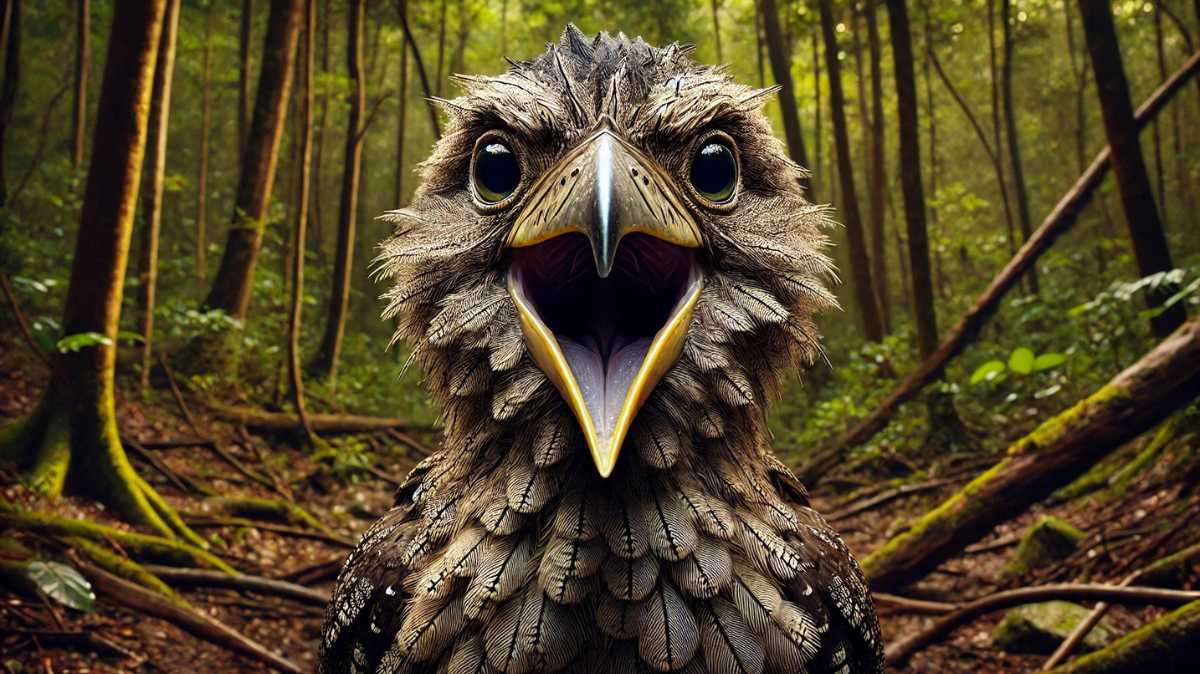The Great Potoo, a nocturnal bird native to Central and South America, is famous for its wide mouth, which plays a vital role in its hunting strategies. The bird feeds on many flying insects, including grasshoppers, beetles, and moths. Using its large gape, the Great Potoo catches insects by flying after them with its mouth open at night, swallowing them whole. Their big eyes help them spot and track prey, while their expansive mouth serves as a net, grabbing insects with a single snap.
When perched, these birds sit motionless, blending perfectly with tree bark during the day. If threatened, they open their mouths wide, appearing more intimidating to scare off predators. This combined with their impeccable camouflage, helps them stay hidden. Despite their eerie nighttime calls, which have become a part of local folklore, the Great Potoo is harmless and solitary by nature.
While not currently endangered, habitat destruction could pose a threat to this elusive bird. For now, their population remains stable, allowing birdwatchers to continue marveling at their unique characteristics in the wild.
In this article, we explore into the fascinating biology and behavior of the Great Potoo, particularly focusing on the phenomenon of its mouth open wide, exploring its anatomy, its purpose, and the evolutionary advantages this trait provides. Let’s decode the layers of intrigue surrounding this bird’s open-mouth posture and understand why it has become such a viral sensation among wildlife photographers.
Table of Contents
1. Introduction to the Great Potoo
The Great Potoo is a nocturnal bird belonging to the Nyctibiidae family, renowned for its excellent camouflage abilities and hauntingly eerie vocalizations. Found primarily in Central and South America, this bird’s lifestyle and features have long captivated ornithologists and nature enthusiasts.
Despite its intimidating size, the Great Potoo is a master of stealth, rarely seen during the day. Blending seamlessly with tree trunks, this bird’s cryptic feathers allow it to remain hidden even in plain sight. However, one of its most remarkable and visually striking behaviors is its ability to open its mouth extraordinarily wide, which serves multiple purposes essential to its survival.
The image of the mysterious Great Potoo’s wide-open mouth has captivated bird enthusiasts and photographers alike, sparking curiosity about its unusual behavior.
2. Anatomy of the Great Potoo’s Mouth
When the Great Potoo opens its mouth, the sight can be unsettling, especially given the bird’s otherwise motionless demeanor. The Great Potoo has an unusually large and gaping mouth, which is much larger in proportion to its head compared to other birds.
Mouth Structure: The Potoo’s mouth is wide and gaping, extending almost the entire width of its face. It’s this structure that allows the bird to effectively catch prey mid-flight, such as insects and small vertebrates.
Adaptation for Hunting: The broad, cavernous mouth acts like a trap, enabling the bird to efficiently catch flying insects. It can open wide in a split second, engulfing its prey in a single, swift motion.
3. Why Does the Great Potoo Open Its Mouth?
The open-mouth posture serves various purposes for the Great Potoo, and its significance goes beyond mere feeding. Some key reasons include:
Defensive Mechanism: When threatened, the Great Potoo may open its mouth wide to intimidate potential predators. The sight of its huge mouth, paired with its stiff posture, can give the impression of a larger, more formidable creature.
Signaling or Communication: While its vocalizations are more often used for communication, the act of mouth gaping may also play a role in non-verbal signaling, possibly between mates or to warn other birds of potential danger.
4. Hunting Techniques: How the Mouth Helps
The wide mouth of the Great Potoo is crucial in its nocturnal hunting strategy. This bird hunts by remaining perched motionless on a branch, waiting for prey to come close. The instant a flying insect or small vertebrate passes by, the Great Potoo swiftly opens its large mouth to catch its prey with minimal effort.
Precision in Hunting: This efficient predation technique allows the bird to conserve energy while catching substantial amounts of food. The wide mouth acts almost like a net, capturing prey on the wing.
Mouth Gaping as Camouflage: Interestingly, even the gaping mouth can be part of the Great Potoo’s camouflage. When the bird sits still, with its mouth slightly open, it can mimic a broken part of a tree or a hollow, further deceiving both prey and predators.
5. Behavior of the Great Potoo
The Great Potoo is largely sedentary during the day, relying on its cryptic plumage to remain concealed. It becomes most active at dusk and night, when it embarks on its nocturnal hunting activities.
Nocturnal Lifestyle: Unlike many birds that are active during the day, the Great Potoo is a night hunter. Its adaptations, including excellent night vision and silent flight, allow it to move stealthily through its forested habitat.
Silent Flight and Stealth: Another remarkable trait of the Great Potoo is its silent flight, which aids in sneaking up on its prey without being detected. Its feather structure is specially adapted to reduce noise during flight, ensuring its approach remains unnoticed by both prey and potential predators.
6. Vocalizations and Sound Production
The Great Potoo’s vocalizations are hauntingly eerie, often described as ghostly or mournful wails echoing through the night. These calls serve to communicate with other Potoos and to establish territorial boundaries.
- Use of Mouth in Sound Production: The large, gaping mouth is also instrumental in sound amplification. When calling out into the night, the open mouth allows the sound to resonate more effectively, giving it a haunting, far-reaching quality.
7. Mimicry and Camouflage Strategies
One of the Great Potoo’s most famous survival tactics is its incredible ability to blend into its surroundings. Its plumage mimics the textures and colors of tree bark, allowing it to remain virtually invisible during the day.
- Role of Mouth Gaping in Camouflage: While the bird’s primary form of defense is to remain still, mouth gaping can play a role in making the bird appear larger or more threatening when it feels especially vulnerable.
8. Viral Sensation: Great Potoo’s Open Mouth
The Great Potoo’s wide-mouthed posture has taken the internet by storm, with wildlife photographers capturing stunning images of this bird in the act. With its unique appearance, the Great Potoo’s viral sensation continues to spread, making it one of the most intriguing birds to watch.
9. Comparative Anatomy: Potoo vs Other Birds
In terms of anatomy, the Great Potoo’s wide mouth sets it apart from other nocturnal birds. While owls and nightjars also have broad mouths for catching insects, the Potoo’s is noticeably larger relative to its head size.
10. Habitats of the Great Potoo
The Great Potoo is found primarily in tropical and subtropical forests throughout Central and South America. Its range extends from southern Mexico down to northern Argentina, encompassing a variety of habitats, from lowland forests to mountainous regions.
11. Conservation Status and Challenges
The Great Potoo is not currently listed as endangered, but like many species, it faces threats from habitat destruction and deforestation. Conservation efforts are focused on preserving its natural habitats to ensure that populations remain stable.
Frequently Asked Questions (FAQs)
What is the Great Potoo’s primary diet? The Great Potoo feeds mainly on insects, particularly moths, beetles, and other flying nocturnal creatures.
Does the Great Potoo use its open mouth as a defense mechanism? Yes, when threatened, the Great Potoo may open its mouth wide to appear larger and more intimidating to predators.
How big can the Great Potoo open its mouth? The Great Potoo can open its mouth to nearly the full width of its face, giving it a shocking appearance.
What is the Great Potoo’s call like? The Great Potoo’s call is a haunting, low-pitched moan or wail that can be heard at night in its native habitats.
Where can I find Great Potoos in the wild? Great Potoos are found across Central and South America, typically in tropical and subtropical forests.
Are Great Potoos endangered? The Great Potoo is not currently endangered, but it faces challenges due to habitat loss.
Author

An aspiring business leader, I am working towards my dream of graduating from Stanford University with a degree in Business Management. Passionate about sharing knowledge, I strive to empower others through education and collaborative learning.
View all posts


